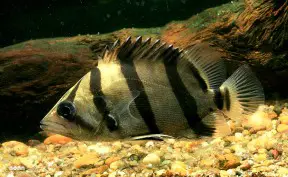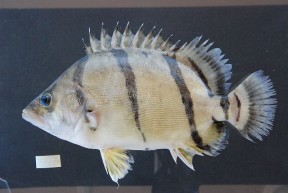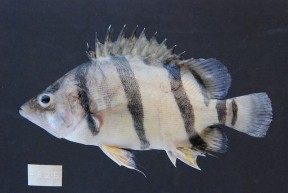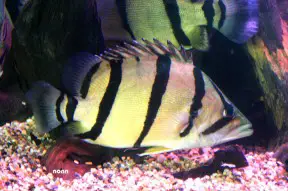Datnioides undecimradiatus
Mekong Tiger Perch
SynonymsTop ↑
Coius undecimradiatus Roberts & Kottelat, 1994
Etymology
Datnioides: from the genus name Datnia and Ancient Greek εἶδος (eîdos), meaning ‘form, likeness’.
undecimradiatus: from the Latin undecim, meaning ‘eleven’, and radiatus, meaning ‘rayed’, in reference to the usual number of soft anal-fin rays in this species.
Classification
Order: Perciformes Family: Datnioididae
Distribution
Known only from the middle and lower Mekong basins in Thailand, Laos, Cambodia, and Vietnam. It has been recorded from several major tributaries including the Xe Bangfai, Mun, and Sekong watersheds.
Type locality is ‘Mekong River, a few kilometers downstream from Lee Pee (or Khone) waterfalls, Laos’.
Habitat
An exclusive inhabitant of large, deep, typically lowland freshwater rivers, and not thought to enter brackish environments.
A variety of factors, including habitat alteration due to construction of dams and other infrastructure, removal of riparian vegetation, and urban pollution, plus over fishing for both human consumption and the aquarium trade, are thought to be exerting a negative effect on wild populations. The species is currently considered ‘Vulnerable’ by the IUCN.
Maximum Standard Length
250 – 300 mm.
Aquarium SizeTop ↑
An aquarium with base dimensions of 180 ∗ 60 cm should be the minimum considered.
Maintenance
Juveniles and subadults should be provided with a well-decorated, planted aquarium with driftwood roots and branches. Larger individuals are relatively unfussy, although some surface cover in the form of floating or overhanging vegetation or branches is appreciated. The addition of marine salt is not required at any life stage.
Datnioides spp. typically produce a lot of waste so the use of large external filters is essential. If possible buy units with built in heaters or at least fit a sturdy heater-guard since adults have been known to damage submerged equipment. Sump systems also work well, and the heater can be housed within.
They do not travel well and can be tricky to stabilise post-import, often refusing to feed and continuously exhibiting a colour pattern indicative of stress but also displayed at night. In D. undecimradiatus the dark body bars fade, leaving only the margins or a series of spots distinctly visible, with the majority of the body greyish, brownish, or blackish.
Water Conditions
Temperature: 20 – 28 °C
pH: 5.5 – 7.5
Hardness: 36 – 268 ppm
Diet
An efficient, largely piscivorous, predator with highly protrusible mouthparts. In the aquarium, juveniles can be offered chironomid larvae (bloodworm), small earthworms, chopped prawn, and suchlike, while adults will accept strips of fish flesh, whole prawns, mussels, live river shrimp, larger earthworms, etc. Older individuals do not require feeding on a daily basis, with 2-3 times per week sufficient.
This species should not be fed mammalian or avian meat such as beef heart or chicken since some of the lipids contained in these cannot be properly metabolised by the fish and may cause excess fat deposits and even organ degeneration. Similarly, there is no benefit in the use of ‘feeder’ fish such as livebearers or small goldfish, which carry with them the risk of parasite or disease introduction and tend not have a high nutritional value unless properly conditioned beforehand.
Behaviour and CompatibilityTop ↑
Can be maintained alongside similarly-sized fishes if sufficient space is available, but might be intimidated by territorial or otherwise competitive species.
Although juveniles may form groups, adults are not gregarious and tend to respond aggressively to conspecifics and similarly-shaped fishes. They are best maintained singly or in a group of 5 or more individuals.
Sexual Dimorphism
Unknown.
Reproduction
Unrecorded.
NotesTop ↑
In aquarium literature D. undecimradiatus is also referred to as ‘Mekong tiger fish’, ‘Northern Thai tiger fish (or ‘NTT’)’, ‘thin bar Siamese tiger fish’, ‘thin bar datnoid’, and ‘thin bar dat’. The names ‘Siamese tiger fish’ and ‘gold datnoid’, though sometimes applied to this species, are more typically applied to its congener D. pulcher. The common name of ‘tiger fish’ is also used in reference to the African alestid genus Hydrocynus, therefore the more appropriate ‘tiger perch’ was suggested by Roberts and Kottelat (1994).
D. undecimradiatus is distinguished from all congeners by the following combination of characters: colour pattern comprising 4 relatively thin dark bars, first bar sometimes not continuous on operculum, not usually extending onto thoracic region or ventral surface of body, sometimes a single, additional smaller bar (vs. 6-7 wide bars in D. microlepis; 4-5 wide bars in D. pulcher; up to 7 bars, sometimes with 1-4 smaller bars between in D. polota; 4-6 wide bars with diffuse margins in D. campbelli; 10-11 (usually 11) branched anal-fin rays (vs. 9-10 in congeners); body scales small, with 70-100 in the lateral series (vs. large, 40-60 in the lateral series in D. polota and D. campbelli); predorsal profile almost straight (vs. distinctly concave in D. polota and D. campbelli).
Following Kottelat (2001), the genus Datnioides is diagnosed by the following combination of characters: second spinous anal-fin ray longer than the first and third rays; presence of fine teeth and 2-3 blunt spines on the edge of the opercle; 50+ lateral line scales; barred colour pattern.
Members were included in the genus Coius during the 1990s, but Coius is now considered to be a synonym of the genus Anabas (Kottelat, 2000). The former family name Coiidae is thus a synonym of Anabantidae, and Datnioides species comprise the monotypic family Datnioididae. The genus has also been included in the marine tripletail family Lobotidae in the past, and preliminary phylogenetic analyses suggest a close relationship these two groups.
References
- Roberts, T. R. and M. Kottelat, 1994 - Ichthyological Exploration of Freshwaters 5(3): 257-266
The Indo-Pacific tigerperches, with a new species from the Mekong basin (Pisces: Coiidae). - Kottelat, M., 2013 - Raffles Bulletin of Zoology Supplement 27: 1-663
The fishes of the inland waters of southeast Asia: a catalogue and core bibiography of the fishes known to occur in freshwaters, mangroves and estuaries. - Kottelat, M., 2000 - Journal of South Asian Natural History 5(1): 91-94
The type species of the genus-group names Coius Hamilton, 1822 and Datnia Cuvier, 1829 and the type-genus of the family-group name Datnioididae Bleeker, 1858. - Kottelat, M., 2001 - WHT Publications, Colombo: 1-198
Fishes of Laos. - Kottelat, M., 1998 - Ichthyological Exploration of Freshwaters 9(1): 1-128
Fishes of the Nam Theun and Xe Bangfai basins, Laos, with diagnoses of twenty-two new species (Teleostei: Cyprinidae, Balitoridae, Cobitidae, Coiidae and Odontobutidae).




